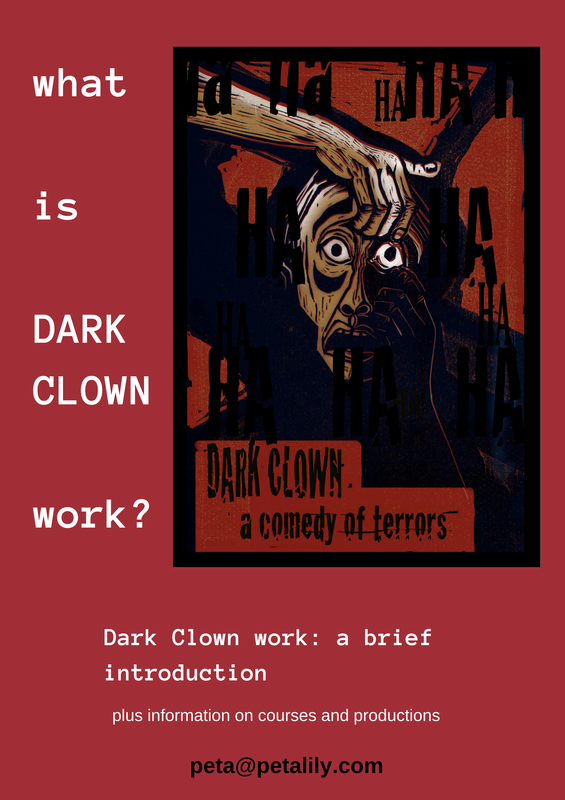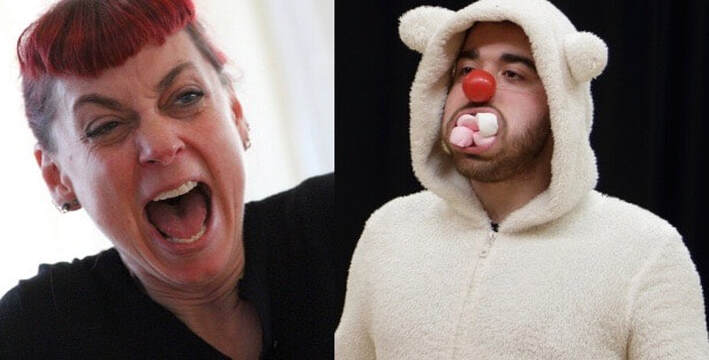 photos: Robert Piwko and Nick Cowell
photos: Robert Piwko and Nick Cowell What happens when Red Nose Clown and Dark Clown meet?
A good number of years ago I was teaching at Central School. The Acting Collaborative and Devised Theatre students were approaching King Lear and I was hired to teach Clown & Dark Clown.
One student asked 'What happens when Red Nose Clown* and Dark Clown meet?' I said 'Let's find out'.
I setup a 'world cafe' where a group hold a conversation by circulating round a circuit of small ‘table’ groups with one person at each ‘table’ staying in place to hold the previous conversations. A group feedback revealed a few main options with some ideas as subsets of those main options. I then asked for people to volunteer as the holders of a particular idea and we held a marketplace where those people 'sold' their idea (again with rotating groups), then at the end, the individuals self-selected into groups to explore each idea.
An Enforced King Lear
I am only going to describe what happened in one of the groups here. Leaning on the idea of Hamlet or Die, and using the concept of the line-up exercise, with someone in place as Controller, one group decided upon the idea of a group of Dark Clowns being forced to perform King Lear, with the unfortunate twist that, as for Hamlet or Die, the deaths and injuries stipulated in the play would be enacted and would be actually painful or - erm - fatal.
'Curtain up'
They began with a line-up of prisoners all with their backs to the audience. Slowly they turned around. They were all terrified, but two of them exhibited a particular fresh breed of alarm. After a few feints and beats, the person in between them revealed themselves. In stark contrast to the others, whose clocks and eye flicks were snatched more nervously, this 'idiot'** was thrilled to be there, delighted to be in company of others and, uniquely … wearing a red nose. For the others in the line-up, the situation was already frightening. Now they see they will have to deal ongoingly with this added unpredictability - a Red Nose Clown who is excited about the games to come – their fear is ramped up, and somewhat coloured with the horror of the uncanny.
Everything we love about the Red Nose Clown - their playfulness, their spontaneity, their good-heartedness, their desire to connect, their mistakes, their delightful capacity to misunderstand, their inability to learn - each quality presents a threat to the poor, hypervigilant Dark Clown players. (Imagine being on a mountain climbing expedition with a prankster.) In the absurd torture realm of an Enforced Performance scenario, The Red Nose Clown’s positive expectations, curiosity and relative invulnerability to pain – bring a terrifying cocktail of uncontrollability, compounding the stressful uncertainty of the line-up Predicament.
As part of the set-up of the line-up exercise, I say - 'The rules in this regime are unknowable, unpredictable. Sometimes they want to punish someone and they shoot your neighbour by mistake. Or sometimes they decide that in order to punish you, they will shoot the person next to you deliberately.' For a fuller explanation of this exercise and the careful set-up for it look at the post on vulnerability. More info in this footnote from the same post.***
The Dark Clown player in a line-up is trying not to attract attention, not to make a mistake, all the while keeping an eye on their neighbours because a wrong step can cost dearly. (Side note: for the Dark Clown, this hyper-vigilance replaces the 'complicité' of the Red Nose Clown. Interestingly, I have often seen that people who have found it hard to notice the other in Red Nose mode, gain a marked improvement in their ability to respond to their fellow players in the Line-up exercise.)
Different rules
Think about Roger Rabbit in the 1988 film Who Framed Roger Rabbit, where live actors and animated creatures co-exist. The poor, grieving human Eddie Valiant (played by Bob Hoskins) is wary of Toons. Toons operate by different rules:
Eddie Valiant : You crazy rabbit! I'm out there risking my neck for you, and what are you doing? Singing and dancing!
Roger Rabbit : But I'm a Toon. Toons are supposed to make people laugh.
...
Roger Rabbit : What could have possibly happened to you to turn you into such a sourpuss?
Eddie Valiant : You really want to know? I'll tell you. A Toon killed my brother.
‘Funny Games’
Coming back to the Red-Nose-meets-Dark-Clown improvisation - I can't remember exactly the beats of this prepared improvisation but I can see the many possibilities - e.g.:
The Controller announces: ‘Act 3, Scene 7! Give out the spoons!’
The Red Nose Clown might rush forward to collect the spoons that are being given out and enthusiastically play them - perhaps urging others to sing 'Old Macdonald had a farm! ... come on everyone, dance!' The poor prisoners, though appalled by Red Nose’s exhortations to dance, comply either out of a nervous reflex or perhaps as a desperate urge to buy time, thereby causing themselves to experience the shame of voluntarily jettisoning one's own dignity.
The Controller could then call a halt to this: 'Get on with it!' - and there could be a poignant (for the audience) tussle as the prisoners who are being forced to step forward to play Cornwall and his servant find themselves in the desperate and ridiculous predicament of having to get the spoons off the Red Nose, who'd either be petulantly protecting his toys or gleefully enjoying the 'no it's mine' tussle. Even though the Dark Clown players would not be relishing what they were being called to do next, they would feel compelled to take possession of the spoons. Maybe Bozo might raise the spoons above ‘Gloucester’ play-acting dramatically and maniacally laughing, this horror would redouble the efforts of the others to claim the spoons. Once successful, a series of takes and clocks would register their satisfaction at prising the spoons off the infuriating Bozo and then continue to map their dawning horror that they have fought, only to find themselves brought abruptly to their ghastly appointed task.
During the preceding tussle, the prisoner awaiting his role as Gloucester would have no choice but to watch in horror. A special horror to have hurt imminent, and to have the threat of hurt prolonged – then on top of that, to have the preparations for the ghastly event of being blinded happen in an atmosphere of child-like chaos and squabbling.
Perhaps, once spoons have been ‘won’ and that painful beat clocked, 'Gloucester' might make a break for it. Red Nose would love this new game of chasey and wrestle the poor Gloucester to the ground, giggling. Maybe Bozo might even tickle poor Gloucester who might then have the humiliation of giggling in response, and segue on to repeatedly call 'stop! stop! stop!' Only to be faced with the inexplicable horror of his command being heeded - and being bundled by all assembled (‘the show must go on’) to be tied to a chair. Before using the rope, Red Nose might do some skipping with it, even pop it into Gloucester's mouth like reins for a quick game of horsey ...
Perhaps with a prompt from the Controller, the ghastly deed is done, at a devastating cost to ‘Cornwall’ and his ‘servant’. They in turn face their deaths.
Each plot event brings games for the Red Nose Clown and that brings ghastly, absurd and exquisitely (painfully) layered predicaments for the Dark Clown players. Bozo misinterprets bodies that fall to the ground or are dragged off - he applauds the dying and wounded, thinking they are play-acting and that he is being a wonderful co-player. Some deaths are seen as a game: "Ashes, ashes, all fall down", he might join in with a falling down lazzi.
So while, in most contexts, the Red Nose Clown provides a ‘pulse of empathy’, in this context, and seen in the light of ‘normal’ reality, Clown antics can be horrific. Roger Rabbit - handcuffed to Bob Hoskins - has preternatural speed and agility and very effectively escapes from danger with his human attached. Bob/Eddie Valiant is slammed into walls and at one stage is dragged down stairs, with his head hitting every step. Only when they are settled and making a plan, does Roger, slip his wrist easily from the cuffs.
Eddie Valiant : You mean you could've taken your hand out of that cuff at any time?
Roger Rabbit : No, not at any time, only when it was funny.
A judicious use if the ridiculous
Adding a skilful touch of the ridiculous to a ghastly situation is a useful technique to release the Troubled Laughter. For example, in the Buzzer exercise, players employ clocks and beats and express the appropriate Marginalised Emotions (strategically, using comedy craft and with audience awareness). It’s helpful/an extra level of skill to add something ridiculous - e.g.: a feigned electric shock, presented believably****, yet which causes the Dark Clown player to spin in a circle like a wind-up toy. Another example: in the setup for The Somali Pirates scenario, I give the players a back story where there is a small past niggle between the two hostages. They are instructed not to play this niggle, but to allow it to bleed into their reactions to the other within the larger predicament. This layering can produce compelling results – a portrayal of a genuine predicament of suffering***** inflected with little micro-beats of flawed humanity – which, once released, can in turn release a further micro-beat of Marginalised Emotion- i.e. ‘Oh no, I was just selfish, in such an awful situation! I feel shame at my own behaviour.’
Before we continue to the end – a bit of a side note here on how ‘nice’ the Red Nose Clown is (actually a bigger conversation than this post can deal with)
The great clown Joey Grimaldi performed for adult audiences, but in the years that followed, Andrew McConnell Stott, author of The Pantomime Life Of Joseph Grimaldi: Laughter, Madness and the Story of Britain’s Greatest Comediannoted, Clowns increasingly became more deemed as a children's entertainment. Following the wonderful re-invigorating of physical theatre styles by Jacques Lecoq, the practice of Clowning has had a renaissance, finding again adult audiences. Sometimes a legacy of the innocence and sweetness of ‘the clown’ remains in people's thinking and/or is debated. Fear of clowns started to become palpable (due to the film It and also to the crimes of John Wayne Gacey. The situation was worsened in 2014 by the ‘creepy clown’ pranking in UK and USA and the regrettable incidents of thugs disguised as scary clowns in France in 2014. I was tracking articles on this rising wave of Coulraphobia as I prepared to make the adult Clown drama The Death of Fun in Hong Kong in 2017.
With more recent events, the whole conversation about Clown is even more complex. Dr Justin Thomas, associate professor at Zayed University in this article takes Jung’s lead and mentions the Clown’s link to the Trickster archetype, saying: 'The positive attributes of the trickster include being wise, funny and intelligent. However, the more negative aspects include being a malicious rule breaker, a cunning thief and a cruel prankster. A psychiatrist might consider such a person a psychopath, diagnosing antisocial personality disorder.' Sadly a couple of notable politicians display a less-than-statesperson-like style which many have described as Clown-like, in early efforts to mock them. Ineptitude may indeed be laughable, but the laughter dies when ineptitude plus power = harm. ******
Another side note - Dramaturgical thinking
If, in the scenario being described here, the Red Nose Clown was portrayed as vulnerable and tender-hearted, it would evoke too much pathos. One of the basic rules of comedy is Contrast – in this Enforced Performance Line-up scenario, any hurt to the Red Nose would eclipse the suffering of the Dark Clowns or bring us to tears and take us (the audience) off the hook. Once in the voice of the Controller, I commanded a Line-up participant to sing. He sang too beautifully. It was exquisite. So exquisite, I had to call the exercise to a halt. We all transcended and felt sorrow (not one of the Marginalised Emotions). It made a moment too poetic for this particular Dark Clown exercise, where compassion is forbidden because it is too humanising. The predicament of the line-up scenario in particular is designed to create conflict (and awful choices), which helps the players release the Marginalised Emotions and which helps to provoke the conflicted Troubled Laughter in the audience. The above scenario works well because the predicament is awful – a playful Red Nose Clown is making it worse for the Dark Clowns.
‘And my poor fool is hanged’ …
Just as the Marx Brothers films need the breathing space of the lover’s plots, Dark Clown dramaturgies are allowed strategic moments of pathos and poetry. (In the context of teaching, I discourage moments of pathos and poetry because it deprives the student of learning the less-familiar Dark Clown craft. But when organising a dramaturgy for the audience, or in a longer duration improvisation with an audience in mind, we can certainly go there. Wonderful if the pathos still keeps the audience on the hook, though – take a look at the dramaturgy for The Maids - i.e. the moment towards the end where one sister is reading the lines of her dying poisoned sister while the audience looks on.)
Finally, only the Red Nose Clown was left on stage. A noose was thrown on stage. Disobeying the chronology of events (do leaders of such a ghastly regime care if the script pages are all present or in order?), we are at the death of Cordelia. Red Nose gleefully put the noose around his neck. Everything is still a game.
I side-coached this excellent young acting student to arrange that the Clown discover by increments that he can actually feel pain after all. Delightfully, he enjoyed playing the fun of wearing the noose like a fashion scarf, the problems, failures and triumphs of stepping up on the chair, then the great feat of standing on the chair! Next the repeated upward throwing of the rope but finding no place to support it. Not to be bested, the resourceful Red Nose tightens the noose, expressing surprise that it in fact pinches a bit - ouchy! - but he laughs and repeats, then whoopsy, losing balance; best sit for safety; oh look it’s a neck tie, I’m a business man; musn’t get sidetracked, the business in hand! etc. He reprises the game of pain and release, sharing all his thinking and emotions with us. New game! A lazzi of suffocation. He really makes the lack of breath look painful, but manages still to telegraph to the audience: ‘What fun!’ A game of pressure and release, game of puffed-out cheeks etc. He keeps delivering all sorts of beats of perplexment, curiousity, pain, the fun of the new, surprise, and fear. Next, a game of how hard it is to keep up the pressure on the rope – he mimes: ‘Phewph, hard work!’, shakes his arm out, tries again. With clown optimism and determination, he redoubles his efforts. Lots of funny little sounds, good rhythm play plus delivering ‘believable’ levels of pain and sharing all the micro-emotions with us, then … the inevitable.
The actor / clown went limp and flowed headfirst onto the floor from his seated position like one of Salvador Dali’s timepieces. A final frozen thumbs up holds, then drops.
‘Men must endure
Their going hence even as their coming hither.’
* For the sake of simplicity, whenever I refer to Clown or Red Nose Clown in these posts, I refer to my own understanding and conception of the form, informed by Clown work as I experienced it with Jacques Lecoq and Philippe Gaulier. There is no one style of clowning. Just to add too, that for me (and some others), actually wearing the little mask of the red nose is not absolutely essential to clowning. I mostly teach without it – especially on short courses.
** A word I use with love and respect in context of the clown!
*** To be specific, if people are not looking like they are really responding to / investing in / embodying the imaginative situation, they are 'shot'. There is an ethical procedure for this - I address the course participant inside the Dark Clown exercise player and say - I am going to shoot you in your hand (or elbow) - do you, the player agree? Do not come out of the situation, just nod so I know you understand ... thank you. I will say "bang" and you will make the appropriate noise.’ The group will have already practiced specific sound-making for a 'believable verisimilitude of pain' in the 'Torture over Ten feet' exercise.
**** Always with the help of the suspension of disbelief.
***** As for *** above - ‘a believable verisimilitude of pain and distress’.
****** ‘Clown’ in common usage, serves as an insult. Clowning as a conscious practice shows a generosity and courage – a practice whereby dignity (at least for the moments spent on stage) is voluntarily jettisoned in the interest of others i.e. in the hope that the ‘sad normals’ may feel, even for a moment, relief: (‘I’m not that stupid’ or ‘Thank heavens, I’m not the only one that stupid’ or ‘Oh how stupid we all are.’) Professional clowns can also can bring: wonder, a slowing of time, poetry, a critique of hierarchy. Someone in power and privilege, with a ‘winning formula’ of a ‘loveable’ clownishness – and who is behaving in ways that cause harm and difficulty to those in their care - is masquerading. They are charming but ultimately conniving.
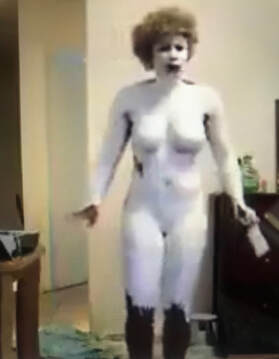
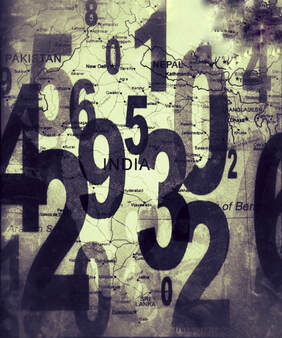
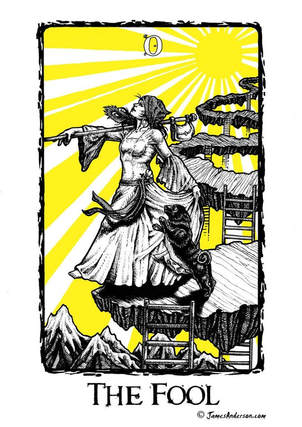
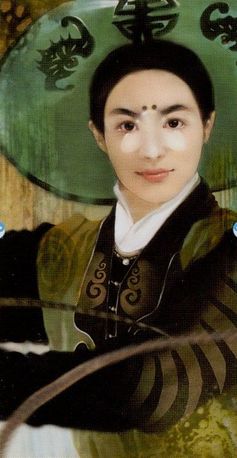
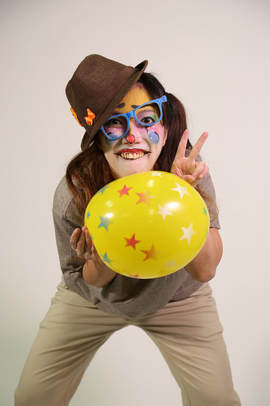
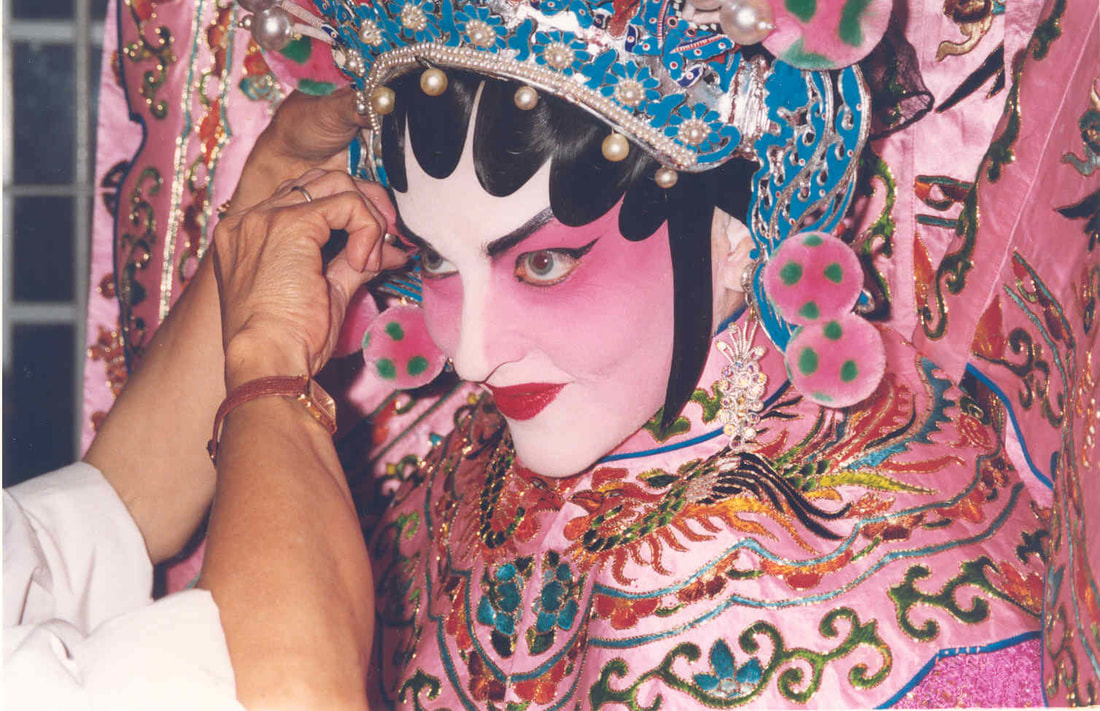
 RSS Feed
RSS Feed
